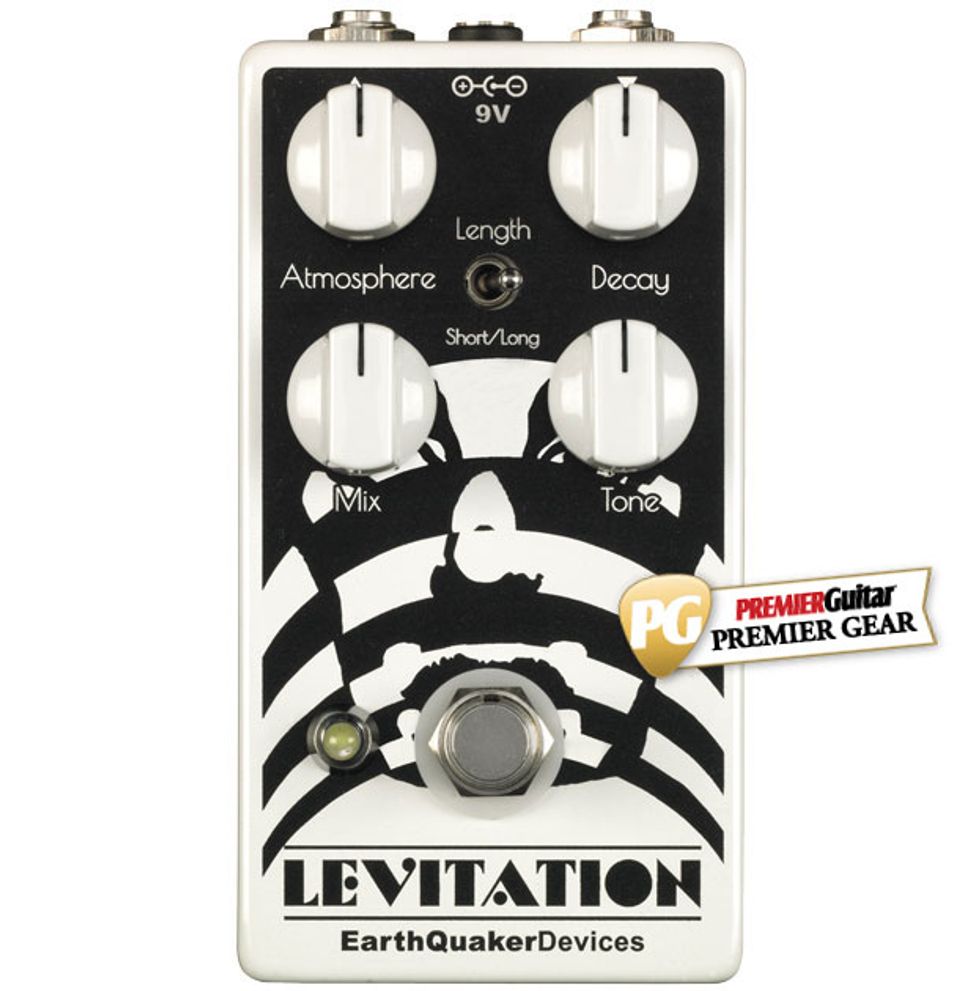
It’s never easy to make digital reverb sound cool. A clever pedal builder will find ways to give it color and character, and a really crafty one will coax just enough spring- or plate-reverb-like shading and digitally derived sweetener to appease all but the most hardened analog fascists. The latter trick is the essence of EarthQuaker Devices’ Levitation Reverb, an expressive, vibrant, and super-dimensional digital box that can stand in convincingly for spring and plate units and generate a light year’s worth of lovely textures outside analog constraints.
Echoes from a Ghost
The Levitation circuit is a close cousin of EarthQuaker’s very spring-reverb-like Ghost Echo, though the Levitation’s functionality differs significantly. Where the Ghost Echo had an attack function (which added clarity to pick attack) and a dwell knob, the Levitation replaces them with a reverb-length toggle and decay, atmosphere, and tone controls. The last of these is a low-cut filter at the front end of the reverb circuit. At its full counterclockwise setting, it eliminates most of the low end hitting the reverb circuit. As you rotate it clockwise, you re-introduce bass frequencies. The atmosphere control, meanwhile, takes high-end content from the reverberated signal and feeds it back through the circuit to create a singing, regenerative harmonic effect.
The heart of the Levitation is an Accutronics BTDR-3H Digi-Log chip, which is essentially three PT2399 chips—one of which is modulated to simulate the electromechanical irregularities of spring and plate reverbs. It’s a great foundation for a digital reverb, and in the Levitation it helps generate tones from subdued to deeply subterranean, and snappy to interstellar.
Phantom Space Surfer
The Levitation’s short reverb settings move from just-barely-there, small-room ambience to more vivid and animated spring sounds. Does it pass the spring-reverb likeness test? Well, yes and no. It has a lot of the resonance and liveliness of a big Fender tank, but it’s much smoother—lacking some of the dirt, electro-mechanical resonance, and artifacts you hear in tube-driven tanks. Does that sound cool?
Ratings
Pros:
Wide range of delicious reverbs—from intimate to atmospheric. Easy-to-explore control set.
Cons:
Traces of digital artifacts in more atmospheric sounds.
Tones:
Ease of Use:
Build/Design:
Value:
Street:
$185
EarthQuaker Devices Levitation Reverb
earthquakerdevices.com
I’m a longtime Fender Tube Reverb user, and I loved the Levitation’s smooth-but-twitching decays and the extra room they provide for exploring the atmosphere and tone controls, which you can use to dial in a little vintage patina. If you’re hell-bent on a dead-on spring emulation, there are pedals out there dedicated to that mission. But the Levitation is arguably a more flexible platform from which you can explore spring-ish realms. Other cool short-reverb settings come with the reverb mix down low, where the Levitation works as a subtle tone-thickening agent without tinting guitar or amp tones too significantly.
The Levitation’s long-reverb toggle settings emulate, to some extent, the properties of plate reverb—though they are not strictly plate-like by design. Instead they offer a very pretty compromise ground between classic plate textures and contemporary digital shimmer-verbs (though on the whole the pedal’s voice tilts toward the former.) You can push long-reverb settings into very spacious regions, and judicious use of the atmosphere control adds trace elements of high-harmonic space dust that lend motion and glow to chord arpeggios and overdriven/boosted solos in particular. You have to be careful not to push the atmosphere control too hard if you’re sensitive to digital’s tendency toward hard-edged decays. These right angles in the fading echoes are not starkly prominent, but in treblier settings and with bright amplifiers they will show up.
The Verdict
A lot of digital reverbs try to compensate for digital’s intrinsic shortcomings by being all things to all players. The Levitation doesn’t bother with creating the most impossibly ambient echoes or the most immaculately spring-like reverb. Instead it provides a flexible, easy-to-navigate platform for very musical, tasteful, and authentically vintage-flavored ’verbs that sound virtually indistinguishable from their inspirations within a band mix. Even with my own predilections for Fender reverb tanks, I loved the Levitation’s smooth echoes and bright-to-dusky vocal range in short-reverb mode. And while the long reverbs can reveal faint digital artifacts at extreme atmosphere, delay, and tone settings, they can also be sparkling and vibrant, thanks to the controls’ range and sensitivity. If the Levitation is a pedal of compromises, they are smart ones—and they add up to a genuinely utilitarian and expressively varied effect.








![Rig Rundown: Russian Circles’ Mike Sullivan [2025]](https://www.premierguitar.com/media-library/youtube.jpg?id=62303631&width=1245&height=700&quality=70&coordinates=0%2C0%2C0%2C0)

















